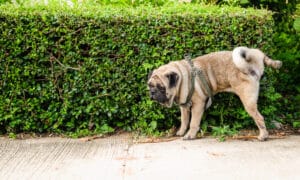“This post contains affiliate links, and I will be compensated if you make a purchase after clicking on my links.”
Canine incontinence causes and treatments are something you need to familiarize yourself with, especially as your pup ages. Taking care of senior dogs can be a challenge due to the fact that their health deteriorates and they are not as physically active as they were back in their younger days. When dogs grow older, like humans, they may develop illnesses that can be quite unavoidable, depending on their overall health. One such is incontinence, or the fact that your dog can no longer control his urination or elimination. Just as happens with humans, in dogs this can also lead to many other related diseases like skin infections, urinary tract problems, kidney problems and bladder infections.
Canine Incontinence Causes and Treatments
The causes of incontinence can vary per breed and age. If the episodes are frequent, and the dog has normal access to the outdoors, it is very important to diagnose the cause and get treatment as soon as possible to prevent infections and other additional problems.
It is more common in female dogs and can often lead to skin infections due to the dog’s constant licking its skin. Being female canines are the usual victims of dog incontinence, one of the major reasons of this illness is that the level of estrogen in a female dog decreases when they age, which eventually leads to lesser muscle tone (especially in the dog’s bladder). But for most male dog cases, the problem is not because of hormone level decrease, but because of bladder stones.
And as mentioned above, dogs with incontinence are more prone to infections of the urinary tract. If the dog’s bladder is infected or irritated, the dog can experience much more frequent urinating and needing to go outside to relieve themselves. There may also be blood mixed with the urine. Other possible causes of canine incontinence are kidney damage, Cushing’s Syndrome, and canine diabetes.
Another reason why it is mostly older female dogs that experience canine incontinence is that when they get pregnant and give birth to too many puppies, their bladder is strained as well, which causes the loss of muscle tone over time.
Another factor can be spaying and neutering, according to this article on the DogTime.com website:
Spayed or neutered dogs are more susceptible to developing the condition because their reproductive organs (which are responsible for the production of hormones) have been removed. Incontinence is most frequently observed in spayed females between the ages of three and five.
Dog incontinence can become a major problem in your household, especially if your dog is already a senior, so a trip to the vet should be scheduled as early as possible. Your vet will examine the dog and determine the cause of his or her incontinence and give you the right medications. And as a responsible owner, you should give your dog the indicated prescriptions at the right dosage. One of the most common medications for dog incontinence is called ‘propalin’ – it has the ability to rehab the urethral muscles, and prevent leaking.
This brief rundown of canine incontinence causes and treatments should give you a good idea of what signs to look for. So at the first signs of dog incontinence, do not hesitate to take action.
Have you ever dealt with an incontinent dog? Share your experiences below.















Deb
Feb 13, 2016 at 1:21 am
Nancy, When you diapered her, how often did you remove the diaper to allow her to toilet? I really appreciate it.
nancy
Jan 17, 2013 at 5:48 pm
I had a rough collie that had an incontinence problem. Nothing helped her–no meds, not even surgery. I ended up putting her in doggie diapers. I did that for 8+ years. So many people thought I should have put her down but I could not do that. She was such a good girl. She tolerated every diaper change and back end baths which took place a few times a day. I would do it again should my Maggie develop incontinence.